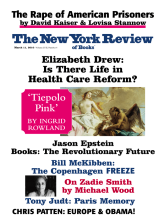In response to:
The Passions of Palladio from the December 17, 2009 issue
To the Editors:
We are two sisters born and living in Vicenza, and we would like to comment on the article “The Passions of Palladio” by Ingrid D. Rowland [NYR, December 17, 2009].
By Ms. Rowland’s description, Vicenza appears more of a ghost town, or a museum, rather than a vibrant city teeming with hundreds of activities and traditions. We are internationally known for our gold and silver artifacts, as well for our post-Fordist industries. Of course, we are just as proud of our industrial achievements as we are of our artistic past and its treasures. Every year, thousand of tourists participate in Vicenza’s international events, like the theatrical season of the Palladio Olympic Theater, the architecture meeting at Villa Cordellina, or the “Fair of Gold,” just to name a few.
Yet this lovely city of two hundred thousand people, which UNESCO has declared a World Heritage Site, is now “being bulldozed into the past” (to quote an American friend who lived long in our city) by the ever-growing expansion of the US military facility [at Dal Molin airport]. The American base is presently in the process of becoming one of the largest American installations in Europe, an expansion whose cost will exceed half a billion dollars. The townspeople have long protested the ill-conceived decision by the Pentagon, but to no avail (see the “No Dal Molin” protest movement). Such a project will certainly influence negatively the city’s art treasures as well as culture. So, here is our letter to inform your readers of what is about to happen to Palladio’s city and its “Passions.”
Lucia Muraro and Michela Muraro
Vicenza, Italy
Ingrid D. Rowland replies:
The Muraro sisters are absolutely right about the risk to Vicenza and its surrounding countryside posed by the Dal Molin facility, and I am grateful that they have called this situation to the attention of the Review ‘s readers.
I see no reference in my review to Vicenza as a ghost town or a museum town, nor would such a thought have occurred to me. I do take their point that an account of the present-day city would have been easy enough to include, and here can only second their remarks about the quality of the city’s textiles and jewelry, its lively population, and its cultural initiatives (some of which, to be honest, are mentioned in my text). As one might suspect from the Muraro sisters’ letter, the Vicentini are also extremely gracious hosts. And of course there is much more to Vicenza and its architecture than Palladio, including a spectacular, recently restored church by the great Baroque architect Guarino Guarini.
I stock my kitchen every fall with as much Vicentine honey as I can carry home; it is a way of keeping a bit of the city with me all year.
This Issue
March 11, 2010



